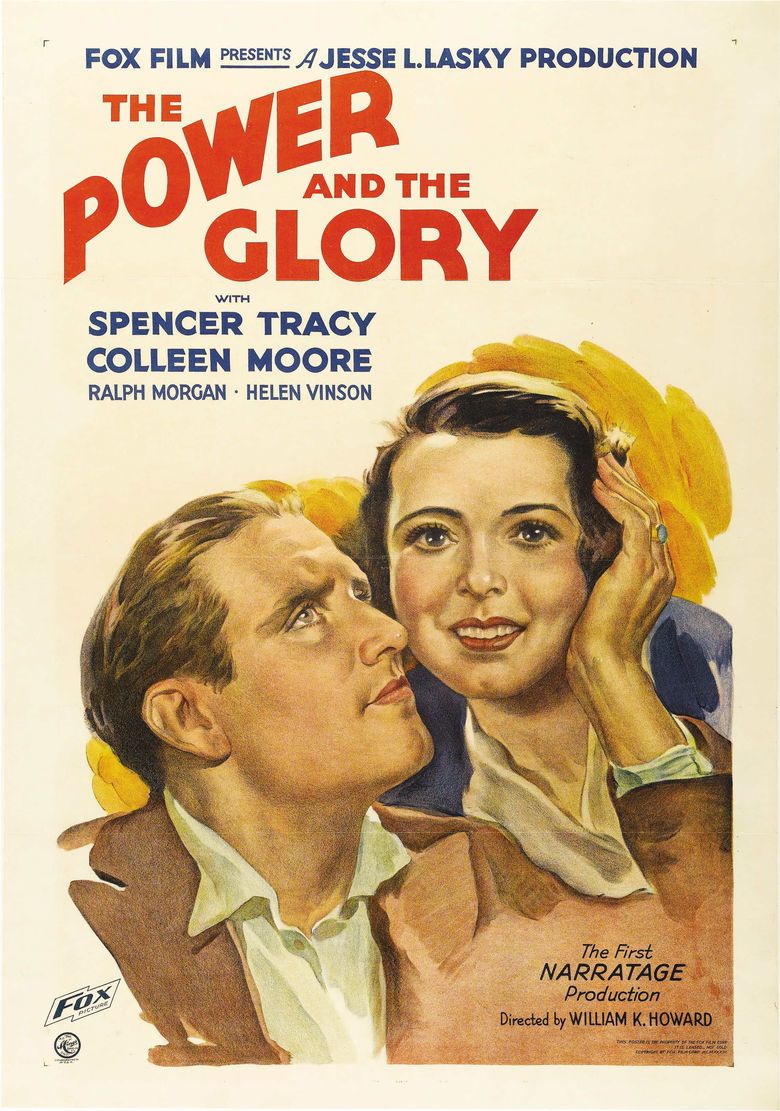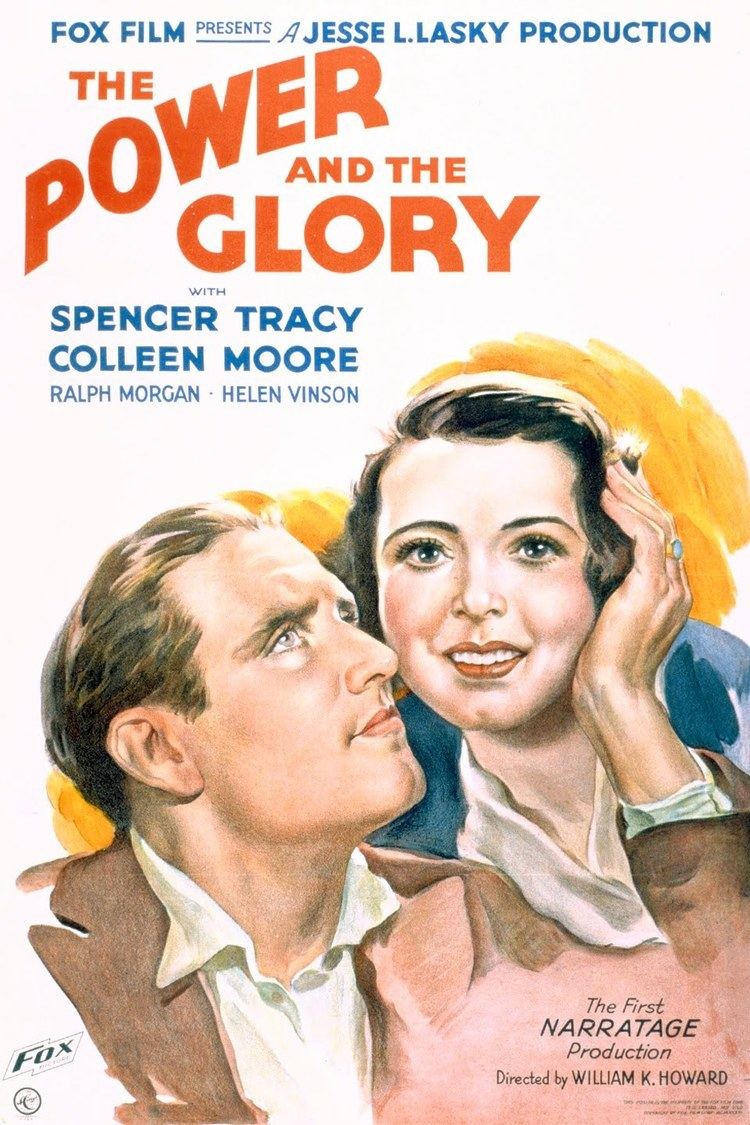The Power and the Glory (1933 film)
6.6 /10 1 Votes6.6
62% Rotten Tomatoes Genre Drama Country United States | 6.9/10 IMDb Duration Language English | |||||||||||||||||||||||||||||||||
 | ||||||||||||||||||||||||||||||||||
Release date August 16, 1933 Cast (Tom Garner), (Sally Garner), (Henry), (Eve Borden), Phillip Trent (Tom Garner, Jr.), (Mr. Borden)Similar movies Lawless , Blazing Saddles , Monster's Ball , Holes , A Single Man , White Fang | ||||||||||||||||||||||||||||||||||
The Power and the Glory is a 1933 Pre-Code film starring Spencer Tracy and Colleen Moore, written by Preston Sturges, and directed by William K. Howard. The picture's screenplay was Sturges' first script, which he delivered complete in the form of a finished shooting script, for which he received $17,500 ($323,800 today) and a percentage of the profits. Profit-sharing arrangements, now a common practice in Hollywood, were then unusual and gained Sturges much attention.
Contents

The film, told through flashbacks, was cited by Pauline Kael in her essay "Raising Kane", as a prototype for the narrative of Citizen Kane (1941). (Screenwriter Herman J. Mankiewicz, who along with Orson Welles won an Oscar for the screenplay of Citizen Kane, was a friend of Sturges.) Tracy's performance in a boardroom scene remains widely considered one of his most thrilling sequences as an actor.
The Power and the Glory was loosely based by Sturges on the life of C. W. Post, his second wife's grandfather, who founded the Postum Cereal Company, which later became General Foods. Like Tom Garner, the lead character of the film, Post worked his way up from the bottom, and ended his own life. Otherwise, according to Sturges, their lives did not correspond.
In 2014, The Power and the Glory was deemed "culturally, historically, or aesthetically significant" by the Library of Congress and selected for preservation in the National Film Registry.
The film is unrelated to the 1940 novel of the same title by Graham Greene.
Premise
After the funeral service for Tom Garner (Spencer Tracy), a powerful and much-hated railroad tycoon who committed suicide, his best friend Henry (Ralph Morgan) recalls Garner's life, his family problems, and his rise from track walker to president of the railroad.
Cast
Production
Sturges originally wrote the script as a freelance project after being let go by Universal Pictures. He told the story to producer Jesse L. Lasky, who had his own unit at Fox, who requested a treatment. Sturges refused to do a treatment, and instead delivered a finished shooting script, which Lasky said was "the most perfect script I'd ever seen", with nothing that needed to be trimmed.
Sturges offered the script to Lasky for $62,475, but Lasky instead structured a deal in which Sturges got $17,500 upon signing, 3 1⁄2% of the first $500,000 in receipts, 5% of the next $500,000, and 7% of all receipts over $1,000,000. Such a percentage deal was highly unusual at that time, and caused an uproar among producers and writers.
Both director William K. Howard and Spencer Tracy were supposed to have worked on Marie Galante, but when it was postponed, they were transferred to The Power and the Glory. Irene Dunne and Mary Astor were both considered for the part of Sally Garner, eventually played by Colleen Moore. Moore was lent to Fox by MGM, as was Helen Vinson, and had not appeared in a film since 1929.
The film was in production from 23 March to late April 1933, with some re-shooting in June 1933. It had originally been set to begin in late February 1933, but was postponed several times.
Location shooting took place at the Hasson station beyond the Santa Susana Pass, using the largest locomotive in the west, leased from the Southern Pacific Railroad; and at the Iverson Ranch in Chatsworth, California.
During filming, Sturges served as the dialogue director, working with the actors much as he had done in stage rehearsals as a playwright.
The film was previewed in Los Angeles on 17 June 1933, and after objections from the Hays Office about the sexual nature of the relationship between a stepmother ("Sally Garner") and her stepson ("Tom Garner Jr."), some re-editing was done. When this did not satisfy the censors, reshooting and more extensive re-editing was done to alleviate their concerns. The film was premiered in New York City on 16 August 1933, and was generally released on 6 October of that year. Fox coined the word "narratage" to describe the non-chronological narration of the story.
Response
Although the film was well received by critics, and Spencer Tracy's performance was especially praised, the film did not do well at the box office, except in New York City. The film was a box office disappointment for Fox. By the end of 1940, it had grossed a little over a half-million dollars, which meant that Sturges had only received about $2,000 over his advance. By 1957 it had grossed around a million.
Sturges' innovative narrative structure was singled out by critics, and the praise was so great, the studio put a bronze plaque up on the New York movie theater where it had its world premiere. The bronze tablet hailed The Power and the Glory as "the first motion picture in which narratage was used as a method of telling a dramatic story."
Sturges' screenplay was widely praised. It was published in book form in 1934, and he received the 1933 Hollywood Reporter Award of Merit for Best Original Story.
Temporarily lost film
When film critic Pauline Kael wrote "Raising Kane", her seminal 1971 New Yorker article on the genesis of Citizen Kane, The Power and the Glory was virtually a "lost film". After writing about how "Hollywood" had praised the movie back in 1933 by putting up a bronze plaque on the New York movie theater where it had its premiere, she chided the movie industry for failing to preserve it.
"Hollywood, big on ballyhoo but short on real self-respect, failed to transfer the nitrate negative to safety stock, and modern prints of The Power and the Glory are tattered remnants." The movie was later restored and is now complete.
References
The Power and the Glory (1933 film) WikipediaThe Power and the Glory (1933 film) IMDbThe Power and the Glory (1933 film) Rotten TomatoesThe Power and the Glory (1933 film) themoviedb.org
